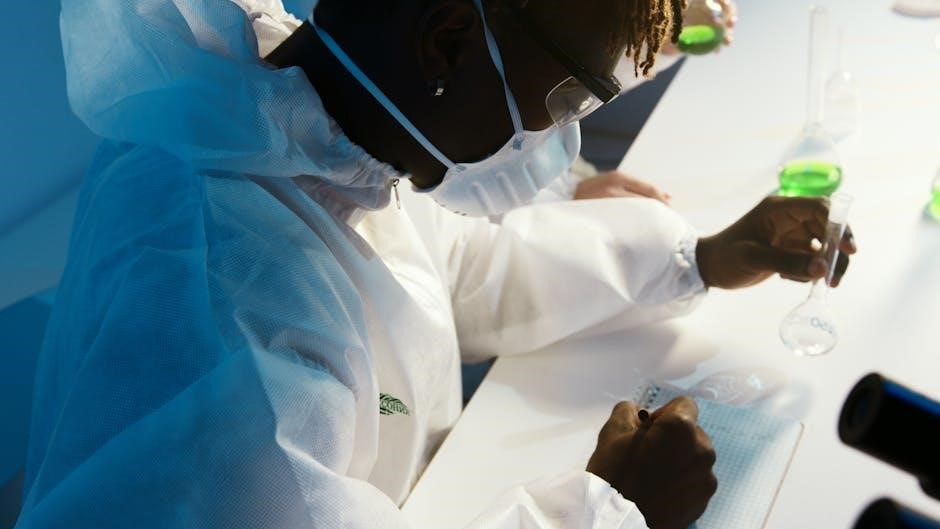Meniscus Tear Rehab Protocol PDF: A Comprehensive Guide
This guide outlines a structured approach to rehabilitation after a meniscus tear, focusing on four phases: immediate post-operative care, intermediate protection, advanced strengthening, and return to activity. It includes exercises, bracing, and cryotherapy to ensure proper healing and prevent re-injury.
Meniscus tear rehabilitation is a structured process designed to restore knee function, reduce pain, and prevent further injury. The meniscus, a cartilage structure in the knee, plays a crucial role in absorbing shock, stabilizing the joint, and facilitating smooth movement. When a tear occurs, proper rehabilitation is essential to ensure optimal healing and return to pre-injury activity levels.
The rehabilitation process is typically divided into phases, each with specific goals and timelines. These phases are designed to protect the repair, restore range of motion, strengthen surrounding muscles, and gradually reintroduce functional activities. The protocol may vary depending on factors such as the location and severity of the tear, the patient’s overall health, and whether surgical intervention was required.
Key components of meniscus tear rehabilitation include targeted exercises, bracing, and cryotherapy. Exercises focus on improving quadriceps and hamstring strength, while bracing provides additional support during the healing process. Cryotherapy helps manage swelling and pain, especially in the early stages.
A well-structured rehabilitation plan, tailored to the individual’s needs, is critical for achieving a successful outcome. Progression through each phase is criterion-based, ensuring the knee is ready for increased demands before advancing to the next stage. This approach minimizes the risk of re-injury and promotes long-term joint health.
Phase 1: Immediate Post-Operative Period (0-2 Weeks)
The first phase of meniscus tear rehabilitation focuses on protecting the surgical repair and managing pain and swelling. Immediately following surgery, patients are advised to avoid putting weight on the affected knee, often using crutches for mobility. A knee brace is typically worn to stabilize the joint and limit movement, usually allowing only 0 to 90 degrees of flexion to prevent strain on the repair.
Cryotherapy, such as icing the knee for 15-20 minutes several times a day, is recommended to reduce inflammation. Pain management may include prescribed medication to alleviate discomfort during this initial healing period. Patients are encouraged to elevate the leg above heart level to minimize swelling.
Gentle exercises are introduced to maintain range of motion and prevent stiffness. These may include straight leg raises, heel slides, and quadriceps sets. It’s crucial to avoid deep squats, pivoting, or any activity that could stress the repair during these first two weeks.
Regular follow-ups with the surgeon are essential to monitor healing progress and address any concerns. Adherence to the protocol during this phase is critical to set the foundation for successful recovery in subsequent stages.
Phase 2: Intermediate Protection Phase (2-6 Weeks)
During this phase, the focus shifts to gradually increasing knee mobility and strength while still protecting the repair. Patients typically progress to partial weight-bearing activities by week 2 and full weight-bearing by week 6, provided there are no complications. The knee brace may be unlocked to allow 0-90 degrees of motion, but it should still be worn during activities and at night for protection.
Exercises are expanded to include gentle strengthening exercises such as straight leg raises, mini squats (avoiding deep flexion), and seated hamstring stretches. Patients are encouraged to continue using cryotherapy as needed to manage any residual swelling. Heel slides and passive range-of-motion exercises are also emphasized to improve flexibility without putting excessive stress on the meniscus.
Patients should avoid activities that involve deep knee bending, pivoting, or high-impact movements during this phase. Regular physical therapy sessions are crucial to monitor progress and ensure proper technique. By the end of this phase, most patients achieve significant improvement in knee function and are prepared to transition to more advanced strengthening exercises in the next phase. Consistency and adherence to the protocol are key to maintaining progress.
Phase 3: Advanced Strengthening Phase (6-12 Weeks)
During this phase, the focus shifts to advanced strengthening and functional exercises to restore full knee function. Patients are typically cleared for full weight-bearing activities without a brace, though they may continue to use it during high-risk activities. The goal is to improve muscle strength, endurance, and joint stability, preparing the knee for more dynamic movements.
Exercises progress to include resistance training with weights or resistance bands, focusing on the quadriceps, hamstrings, and calves. Agility drills, balance training, and plyometric exercises are introduced to enhance proprioception and functional strength. Patients are also encouraged to engage in low-impact cardiovascular activities such as swimming or cycling to improve overall fitness without stressing the knee excessively.
It is important to avoid deep squats or lunges until at least 12 weeks post-operatively to protect the meniscus repair. Regular follow-ups with the physical therapist are essential to assess progress and adjust the exercise program as needed. By the end of this phase, patients should demonstrate significant improvements in strength, flexibility, and functional ability, setting the stage for a safe return to activity in the next phase. Consistency and proper form during exercises are critical to achieving optimal results.
Phase 4: Return to Activity Phase (3-6 Months)
During this final phase, the focus is on gradually returning to pre-injury activity levels while minimizing the risk of re-injury. Patients typically achieve full strength and functional abilities, allowing them to resume sports or high-level activities. The program emphasizes dynamic exercises, sports-specific drills, and high-impact activities tailored to the individual’s needs.
Patients are encouraged to engage in functional activities such as running, jumping, and pivoting, provided they remain pain-free and demonstrate proper movement mechanics. Plyometric exercises are introduced to restore explosive power, and balance training is continued to ensure stability. Bracing may still be recommended during high-risk activities for added protection.
Progression to full activity is criteria-based, with clearance from the healthcare provider. Patients must demonstrate full range of motion, strength, and functional ability before returning to unrestricted activities. Monitoring for any signs of pain or swelling is crucial, as overloading the knee can lead to setbacks. This phase ensures a safe and gradual transition back to normal activities, with long-term focus on maintaining knee health and preventing future injuries. Consistency in rehabilitation efforts remains key to achieving a successful outcome.
Key Rehabilitation Exercises for Meniscus Repair
Rehabilitation exercises are crucial for restoring strength, flexibility, and function after a meniscus repair. Early-stage exercises focus on maintaining range of motion and reducing stiffness, such as heel slides and straight leg raises. As healing progresses, strengthening exercises like mini squats, step-ups, and hamstring curls are introduced to target the quadriceps, hamstrings, and calf muscles.
Advanced exercises, such as balance training on a BOSU ball or foam pad, improve proprioception and stability. Functional activities like lunges and agility drills are incorporated to prepare the knee for dynamic movements. It’s essential to avoid deep squats, pivoting, or high-impact activities until full strength and stability are achieved.
Exercises should be performed with proper form to avoid putting unnecessary strain on the knee. Progression is gradual, with resistance and complexity increased as tolerated. Consistency and adherence to the exercise program are key to achieving a successful recovery and preventing future injuries. Always consult a healthcare professional before starting any rehabilitation program.
Importance of Bracing and Cryotherapy in Recovery
Bracing and cryotherapy are essential components of meniscus tear rehabilitation, playing critical roles in protecting the repair and managing post-operative discomfort. A brace is often recommended to stabilize the knee, particularly in the early stages of recovery. It helps limit excessive movement that could stress the repair site, promoting a safer healing environment. Patients are typically advised to wear the brace during weight-bearing activities and at night for added protection.
Cryotherapy, or ice therapy, is routinely used to reduce swelling and pain. Applying ice to the affected knee for 15-20 minutes several times a day helps minimize inflammation and discomfort. This practice is especially beneficial in the first 72 hours post-surgery but can continue as needed throughout the recovery process.
Both bracing and cryotherapy are integral to the initial phases of recovery, ensuring the meniscus repair remains protected while the tissue heals. These strategies, combined with a structured rehabilitation program, help optimize outcomes and reduce the risk of complications. Always follow specific guidelines provided by your healthcare provider for proper use of these tools.
Progression Criteria for Each Rehab Phase
Progression through the rehabilitation phases following a meniscus tear or repair is based on specific, measurable criteria to ensure safe and effective healing. In Phase 1 (0-2 weeks), patients must demonstrate reduced pain, minimal swelling, and the ability to bear weight as tolerated. Achievement of these milestones allows transition to Phase 2 (2-6 weeks), where goals include restoring full range of motion, improving strength, and advancing weight-bearing activities.
In Phase 3 (6-12 weeks), progression is contingent upon achieving strength levels close to the uninjured knee, excellent functional mobility, and the ability to perform low-impact activities without discomfort. Finally, in Phase 4 (3-6 months), patients must exhibit near-normal strength, full functional capabilities, and the ability to perform high-impact or sport-specific movements without pain or instability.
Each phase is criterion-based, ensuring patients only advance when they have met the necessary benchmarks. This approach minimizes the risk of re-injury and promotes optimal recovery outcomes. Regular clinical assessments and patient-reported feedback guide the progression. Avoiding premature advancement is crucial to protect the healing meniscus and achieve long-term success.
Common Mistakes to Avoid During Meniscus Rehab
Avoiding common mistakes during meniscus tear rehabilitation is crucial for ensuring proper healing and preventing re-injury. One of the most frequent errors is returning to activity too quickly, which can disrupt the repair and prolong recovery. Patients often underestimate the importance of adhering to the structured phases of rehab, leading to premature stress on the healing tissue.
Another mistake is ignoring the use of braces or supportive devices during the early stages, especially for individuals with ligamentous instability. Additionally, overexertion during exercises can strain the knee, delaying progress. Many patients also fail to prioritize consistent cryotherapy to manage swelling, which is vital in the initial phases.
Neglecting to follow weight-bearing guidelines is another common oversight, particularly for those with root tears. Patients must avoid deep squats and high-impact activities until cleared by their clinician. Lastly, poor communication with the rehabilitation team can lead to misunderstandings about progression criteria, putting patients at risk of complications. Adherence to the protocol and open dialogue with healthcare providers are essential for a successful outcome.


